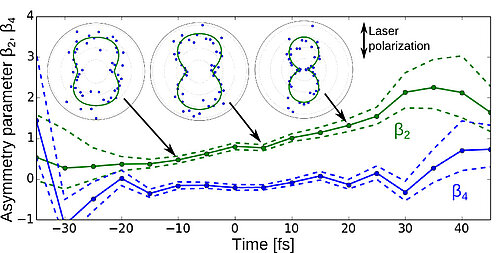Electronic auto-ionization is a process in which the movement of several excited electrons in an atom or molecule leads with delay to the emission of a single electron. Despite a long history of research, the theoretical description of this process still presents difficulties today. This applies in particular to the case of energy overlapping autoionizing resonances. The difficulties are fundamental because their origin lies in the fundamental problems of describing a dynamic process in the energy space. The researchers from the Max Born Institute have now been able to demonstrate this ultra-fast dynamic process directly during the period by means of new technical developments in the field of ultrashort XUV pulses.
Ultrafast photoelectron spectroscopy reveals wrinkles between different autoionization channels
Fig. 1 Angle distribution of photoelectrons generated by the ionization of an auto-ionizing resonance in molecular nitrogen by a weak IR pulse. The embedded windows show the angular distribution for different time delays. The green and blue curves show the time dependence of the asymmetry parameters of the angular distribution. The angular distribution is described here by Legendrepolynome second and fourth order.
Rev. Lett. 116, 163003 (2016)) uses a newly constructed time-delay-compensating monochromator that selectively excites a single auto-ionizing resonance in nitrogen molecules through an XUV pulse. The dynamics are then mapped by ionization of the molecule with a second IR pulse within a pump-probe experiment. This happens on a timescale below 15 fs. The generated photoelectrons are imaged with a "Velocity Map Imaging" spectrometer, which measures not only the kinetic energy of the electrons but also the angular distribution of the electrons. The experiment showed that the angular distribution of the photoelectrons changes during autoionization (Figure 1). Immediately after the excitation of the resonance, the angular distribution is relatively isotropic. With a larger pump-probe delay it can then be observed that the electrons are mainly emitted in the direction of the laser polarization. This observation can only occur when two electronic states are excited. A possible existence of such energetically overlapping states in nitrogen was predicted theoretically more than 30 years ago and has now been experimentally observed for the first time. In the experiment different disintegration times are observed for the energetically overlapping excited states.
Two overlapping electronic states, each having a short and longer lifetime, can theoretically be explained by interference stabilization. This is a phenomenon that also occurs with atoms that are within an electric strong field. Interference stabilization occurs when quantum mechanical interference between different autoionization states leads to a change in the duration of the individual ionization channels. The duration of one channel is shortened while the other lengthens. Further experiments and improved theoretical description are intended to determine the extent to which the phenomena observed here in the experiment are of a general nature and therefore of great importance for the general understanding of autoionization in molecules.
Search publications of MBI
Publications since 2025
